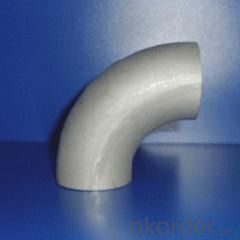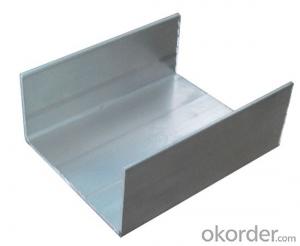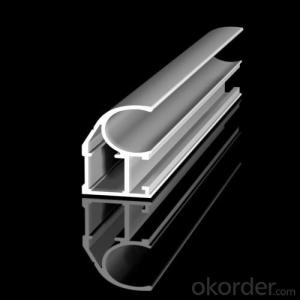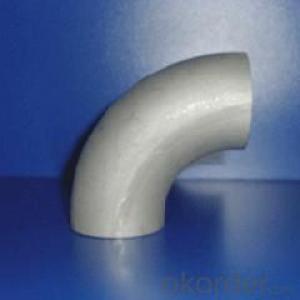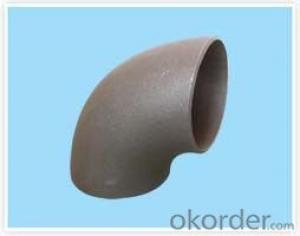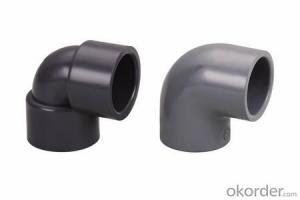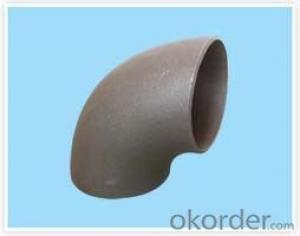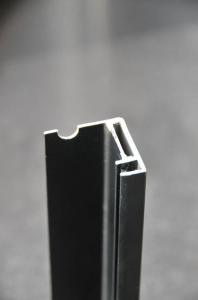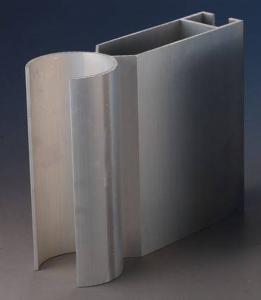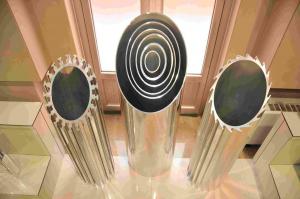Half Round Aluminum Extrusion Profiles - Aluminum Elbow 45 Degree Profile
- Loading Port:
- China Main Port
- Payment Terms:
- TT OR LC
- Min Order Qty:
- -
- Supply Capability:
- -
OKorder Service Pledge
OKorder Financial Service
You Might Also Like
Specifications
45 degree aluminum elbow
1.size:1/2"-48"
2.standard:ASTM B16.9
3.Certification: ISO
Type | 45 degree elbow |
Size | 1/2"-48"DN15--DN1200 |
Wall Thickness | Sch5--Sch160XXS |
Standard | ISO, SNSI, JIS, DIN, GB/T12459GB/T13401ASME B16.9SH3408 SH3409HG/T21635HG/T21631SY/T05010 |
Material | 20#/Q235 |
Packaging | wooden cases or wooden pallet or as per customers requirement |
Applications Range | petroleum, chemical, power, gas, metallurgy, shipbuilding, construction, etc |
Min Order Quantity | According to customer's requirement |
Delivery Time | According to customer's requirement |
Quality | First grade |
Productivity | 8000000T/Y |
Others | 1.Special design available according to requirement 2.Anti-corrosion and high-temperature resistant with black painting 3. All the production process are made under the ISO9001:2008 strictly. |
- Q: Is it possible to use aluminum profiles as a material for exterior walls or facades?
- <p>Yes, aluminum profiles can be used for exterior cladding or siding. They are known for their durability, low maintenance, and resistance to weather and corrosion, making them ideal for exterior applications. Aluminum profiles are lightweight, easy to install, and can be painted or finished in various ways to match architectural designs. They also offer excellent thermal performance and can be recycled, contributing to sustainability.</p>
- Q: What are the different surface brushing options for aluminum profiles?
- The different surface brushing options for aluminum profiles include mechanical brushing, chemical brushing, and electrochemical brushing. Mechanical brushing involves the use of abrasive materials or brushes to create a brushed finish on the surface. Chemical brushing involves the application of chemicals or acids to etch the surface and create a brushed effect. Electrochemical brushing uses an electric current to create a brushed finish by removing material from the surface.
- Q: Which aluminum profile is better here in Guangdong?
- I think it should be a male aluminum bar, doing things very reassuring, things are also very good. Satisfied, please adopt ha!
- Q: What are the weight limitations of aluminum profiles?
- The weight limitations of aluminum profiles depend on various factors such as the dimensions, shape, and structural integrity of the profile itself. Aluminum profiles are generally lightweight and have a high strength-to-weight ratio, making them suitable for a wide range of applications. However, the maximum weight capacity will vary depending on the specific profile design and the intended use. Aluminum profiles can typically support a significant amount of weight, especially when they are properly engineered and reinforced. For simple structural applications, such as framing or support systems, aluminum profiles can handle loads ranging from a few hundred pounds to several thousand pounds. These profiles are commonly used in industries like construction, automotive, aerospace, and manufacturing. It is important to note that the load-bearing capacity of aluminum profiles can be enhanced through various techniques, such as increasing the thickness or adding reinforcing elements like gussets or braces. These modifications help to distribute the weight and improve the overall strength of the profile. Additionally, it is crucial to consider other factors such as the length of the profile, the type of connection or fastening method used, and the overall stability of the structure. These factors can affect the weight limitations and overall structural integrity of the aluminum profiles. To determine the specific weight limitations of aluminum profiles for a particular application, it is recommended to consult with a structural engineer or refer to the technical specifications provided by the manufacturer.
- Q: What are the specific needs or standards for utilizing aluminum profiles in cold weather conditions?
- <p>In cold climates, aluminum profiles must meet certain requirements to ensure durability and functionality. These include resistance to extreme temperatures, which may affect the material's strength and flexibility. Profiles should be made from high-quality aluminum alloys designed for low-temperature performance. Additionally, proper thermal breaks may be necessary to prevent heat loss through the profile. Corrosion resistance is also crucial, as cold environments can accelerate the process. Lastly, it's essential to consider the expansion and contraction of aluminum in cold temperatures, ensuring the design accommodates these changes to prevent warping or cracking.</p>
- Q: Features of aluminum profiles
- Thermal conductivityThe thermal conductivity of aluminum alloy is about 50-60% of copper, which is beneficial to the manufacture of heat exchangers, evaporators, heating appliances, cooking utensils, and the cylinder head and radiator of automobiles.FerromagnetismAluminum is non ferromagnetic, which is an important feature of the electrical and electronic industries. Aluminum can not be spontaneous combustion, which is involved in loading and unloading or exposure to flammable and explosive materials is important.
- Q: How do aluminum profiles perform in terms of sound insulation?
- Aluminum profiles typically offer poor sound insulation due to their lightweight and low density. They do not effectively block or absorb sound waves, making them less suitable for applications that require high levels of soundproofing.
- Q: What industries commonly use aluminum profiles?
- Aluminum profiles find wide applications in various industries, owing to their unique properties and versatility. The construction industry is one of the major sectors that extensively employs aluminum profiles. These profiles are utilized in the construction of windows, doors, curtain walls, and other architectural components. The lightweight nature of aluminum makes it an ideal preference for such applications, as it reduces the burden on the building structure. Similarly, the automotive industry heavily relies on aluminum profiles for manufacturing purposes. These profiles are used in the production of car frames, body panels, and components, offering an exceptional strength-to-weight ratio and corrosion resistance. By incorporating aluminum profiles, the overall weight of vehicles is reduced, resulting in improved fuel efficiency and performance. Aerospace manufacturing is another sector that heavily depends on aluminum profiles. These profiles are employed in constructing aircraft frames, wings, and fuselages. Their high strength and durability make them suitable for enduring the challenges of flight, while their lightweight characteristic contributes to fuel efficiency. The electronics industry also finds great utility in aluminum profiles. They are used in the production of heat sinks, aiding in the dissipation of heat from electronic components. Aluminum's excellent thermal conductivity ensures effective heat transfer, safeguarding sensitive electronic devices from damage. Furthermore, the furniture industry adopts aluminum profiles extensively in the production of lightweight and durable furniture pieces. These profiles are used to construct frames for chairs, tables, shelves, and various other furniture items. Their corrosion resistance and aesthetic appeal make them a preferred choice for both indoor and outdoor furniture. In conclusion, industries such as construction, automotive, aerospace, electronics, and furniture commonly embrace aluminum profiles due to their lightweight nature, strength, corrosion resistance, and versatility. These profiles play a vital role in enhancing the performance, efficiency, and durability of products in these industries.
- Q: How do aluminum profiles perform in blast-resistant structures?
- Aluminum profiles perform well in blast-resistant structures due to their high strength-to-weight ratio and excellent energy absorption capabilities. They can effectively dissipate and redirect the force of an explosion, minimizing damage and providing enhanced protection. Additionally, aluminum profiles offer corrosion resistance, durability, and ease of fabrication, making them a suitable choice for blast-resistant construction.
- Q: The company must tender, but it needs material certification, but what do not know exactly?
- Enterprise legal person business license, China Quality Association approved, the national industrial product production permit, 9001 certificate, a copy of tax registration certificate. Surely that will be enough
Send your message to us
Half Round Aluminum Extrusion Profiles - Aluminum Elbow 45 Degree Profile
- Loading Port:
- China Main Port
- Payment Terms:
- TT OR LC
- Min Order Qty:
- -
- Supply Capability:
- -
OKorder Service Pledge
OKorder Financial Service
Similar products
Hot products
Hot Searches
Related keywords

